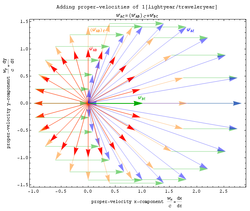Expected Distance of Unit Vectors
 Two unit vectors in two-dimensional space
a
^
and
b
^
are added together. The expected magnitude of the resulting vector
a+b
is equal to
E
.
What is
⌊
1
0
0
E
⌋
?
Two unit vectors in two-dimensional space
a
^
and
b
^
are added together. The expected magnitude of the resulting vector
a+b
is equal to
E
.
What is
⌊
1
0
0
E
⌋
?
Also try Daniel Liu's Expected Distance on a Circle .
Image credit: Wikipedia P.Fraundorf
The answer is 127.
This section requires Javascript.
You are seeing this because something didn't load right. We suggest you, (a) try
refreshing the page, (b) enabling javascript if it is disabled on your browser and,
finally, (c)
loading the
non-javascript version of this page
. We're sorry about the hassle.
3 solutions
Discussions for this problem are now closed
I am not convinced with the answer.
 Image
Image
Fix one of the vectors as i ^ (orange). The other vector (blue) which is at an angle θ with the first one can be picked from a "cone" of vectors (the vectors are in 3-D space) with the probability 4 π 2 π sin θ d θ = 2 sin θ d θ . The magnitude is given by: 2 + 2 cos θ . Hence, the expected value is:
∫ 0 π 2 + 2 cos θ 2 sin θ d θ
@Avineil Jain and @Trevor B. , can you please clarify?
I think I needed to specify that the vectors were in 2-D space. Can you try that again and tell me if you get π 4 ? Sorry for the inconvenience.
Thanks for the quick response!
I got π 4 when I assumed the vectors to be in 2-D space. The problem is OK now, I guess. My argument could be wrong too, though.
@Pranav Arora – I don't know anything about 3-D vectors, so can someone confirm that Pranav's integral would be correct if the vectors were in 3-dimensional space and that the answer would be 3 4 ?
i think ur correct
Well I thought that 2 vectors are always co planar, so this problem becomes limited for 2-D.
Yes, two vectors are always coplanar but you cannot say that there is only one vector which is at some angle to the other, you have infinite choices.
@Pranav Arora – But I still think the "cone" logic is wrong. I am still not convinced what is the harm in approaching this problem by 2-D.
I am not sure if this is correct. Sqrt(x^2) = mod(x) and not x.
It is easy to see angle between two vectors changes from 0 to 2pi, but it is the same for two ranges: [0, pi] and [pi, 2pi]. So can use the expression to calculate: 2 ( 2 π 1 ) ∫ 0 π 2 c o s ( 2 x ) = π 4 ⇒ r e s u l t = 1 2 7
Experimental Mathematics!!
>>> s = 0
>>> import math
>>> addvector = lambda x: math.sqrt(1+1+2*1*1*math.cos(x))
>>> for i in xrange(0,628):
... x = float(i)/100
... s += addvectors(x)
...
>>> int(100*s/628)
127
The net resultant of vectors is given by the cosine law.
Let | a + b | = S
S = 1 + 1 + 2 c o s θ
S = 2 c o s 2 θ
Therefore, average or expected value is given by-
S a v g = ∫ 0 π d θ ∫ 0 π 2 c o s 2 θ d θ
The limits are taken from 0 to π since θ can vary from 0 to π .
S a v g = 1 . 2 7 3
[ 1 0 0 S a v g ] = 1 2 7